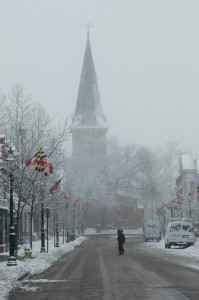
Anne Arundel County Executive Steven R. Schuh is urging Anne Arundel County residents to make their final preparations now for a dangerous winter storm impacting the area within the next 24 hours.
“As the storm gets closer, there is less and less time to prepare,” said Schuh. “I am urging all our citizens to make final preparations for this storm as it moves in Friday afternoon.”
The National Weather Service has issued a Blizzard Warning for an area including Anne Arundel County. A Blizzard Warning is an advisory issued by the National Weather Service which means winds greater than 35 miles per hour, mixed with falling or blowing snow, and visibilities of 1⁄4 mile or less is expected for a period of 3 hours or more. A Blizzard Warning means severe winter weather conditions are expected or occurring. Falling and blowing snow with strong winds and poor visibilities are likely. This will lead to whiteout conditions, making travel extremely dangerous. Do not travel. If you must travel, have a winter survival kit with you.
If you get stranded, stay with your vehicle. Prepare for the possibility of power outages during snowy and cold conditions. The latest predictions are projecting that the Baltimore-Washington area will receive 18 to 24 inches of snow and will be accompanied by high winds which will be a hazard to those who are unprepared or who do not respond prudently to storm conditions. Snowfall is expected to begin falling Friday afternoon and may continue into late Saturday. NOW is the time to complete preparations.
“A blizzard warning is not common for this area and not something that should be taken lightly,” said Fire Chief Allan Graves. “Homeowners and business owners should take this opportunity to complete their preparations for the storm, listen to reliable weather sources for updates and follow directions of emergency officials regarding travel.”
Citizens can minimize their risk of injury to themselves, as well as, property damage from winter storms by taking the following actions during the storm:
During the Storm
- Stay indoors during the storm.
- Walk carefully on snowy, icy, walkways.
- Avoid overexertion when shoveling snow. Overexertion can bring on a heart attack—a major cause of death in the winter. Use caution, take breaks, push the snow instead of lifting it when possible, and lift lighter loads.
- Keep dry. Change wet clothing frequently to prevent a loss of body heat. Wet clothing loses all of its insulating value and transmits heat rapidly.
- Signs of Frostbite: Occurs when the skin and body tissue just beneath it freezes. Loss of feeling and white or pale appearance in extremities, such as fingers, toes, earlobes, face, and the tip of the nose.
- What to Do: Cover exposed skin, but do not rub the affected area in an attempt to warm it up. Seek medical help immediately.
- Signs of Hypothermia: Dangerously low body temperature. Uncontrollable shivering, memory loss, disorientation, incoherence, slurred speech, drowsiness, and apparent exhaustion.
- What to Do: If symptoms of hypothermia are detected take the person’s temperature. If it is below 95°, seek medical attention immediately. Get the victim to a warm location. Remove wet clothing. Warm the center of the body first by wrapping the person in blankets or putting on dry clothing. Give warm, nonalcoholic beverages if the victim is conscious. Seek medical help immediately.
- The U.S. Centers for Disease Control and Prevention (CDC) recommends, if you detect symptoms of frostbite, seek medical care. Because frostbite and hypothermia both result from exposure, first determine whether the victim also shows signs of hypothermia. Hypothermia is a more serious medical condition and requires emergency medical assistance.
- Drive only if it is absolutely necessary. If you must drive: travel in the day; don’t travel alone; keep others informed of your schedule; stay on main roads and avoid back road shortcuts.
- Let someone know your destination, your route, and when you expect to arrive. If your car gets stuck along the way, help can be sent along your predetermined route.
- If the pipes freeze, remove any insulation or layers of newspapers and wrap pipes in rags. Completely open all faucets and pour hot water over the pipes, starting where they were most exposed to the cold (or where the cold was most likely to penetrate).
- Maintain ventilation when using kerosene heaters to avoid build-up of toxic fumes. Refuel kerosene heaters outside and keep them at least three feet from flammable objects.
- Conserve fuel, if necessary, by keeping your residence cooler than normal. Temporarily close off heat to some rooms.
- If you will be going away during cold weather, leave the heat on in your home, set to a temperature no lower than 55ºF.
Dress for the Weather
- If you must go outside, wear several layers of loose-fitting, lightweight, warm clothing rather than one layer of heavy clothing. The outer garments should be tightly woven and water repellent.
- Wear mittens, which are warmer than gloves.
- Wear a hat. A hat will prevent loss of body heat.
- Cover your mouth with a scarf to protect your lungs.
Stranded in a Vehicle
If a blizzard traps you in the car:
- Pull off the highway. Turn on hazard lights and hang a distress flag from the radio antenna or window
- Remain in your vehicle where rescuers are most likely to find you. Do not set out on foot unless you can see a building close by where you know you can take shelter. Be careful; distances are distorted by blowing snow. A building may seem close, but be too far to walk to in deep snow.
- Run the engine and heater about 10 minutes each hour to keep warm. When the engine is running, open a downwind window slightly for ventilation and periodically clear snow from the exhaust pipe. This will protect you from possible carbon monoxide poisoning.
- Exercise to maintain body heat, but avoid overexertion. In extreme cold, use road maps, seat covers, and floor mats for insulation. Huddle with passengers and use your coat for a blanket.
- Take turns sleeping. One person should be awake at all times to look for rescue crews.
- Eat regularly and drink ample fluids to avoid dehydration, but avoid caffeine and alcohol.
- Be careful not to waste battery power. Balance electrical energy needs – the use of lights, heat, and radio – with supply.
- Turn on the inside light at night so work crews or rescuers can see you.
- Leave the car and proceed on foot – if necessary – once the blizzard passes.
Source: AACoFD
[do action=”blackwall-hitch”/]









































